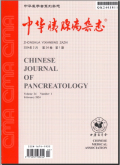胰十二指肠切除术后出血患者的临床特征分析与护理防范策略
Clinical characteristics analysis and nursing management strategy for patients with bleeding after pancreaticoduodenectomy
摘要目的:分析胰十二指肠切除术(PD)术后出血的临床特征,以期探寻高效、实用的护理应对策略。方法:收集2014年1月至2019年12月间海军军医大学第一附属医院62例行PD术后发生出血患者的临床资料,分析患者的出血时间、出血部位、生命体征、出血时伴随症状、外科处理措施及临床结局。结果:62例患者中19例(30.6%)为早期出血(24 h内),43例(69.4%)为迟发出血。36例次(58.1%)为动脉出血。43例次(69.4%)为腹腔出血。32例(51.6%)为C级出血。8例(12.9%)存在前哨出血。42例(67.7%)为腹腔引流管引流出血性液体。出血前23例(37.1%)存在胰瘘,12例(19.4%)存在腹腔感染等并发症。41例次(66.1%)出现休克症状。出血最早在术后0.3 h发现,最迟在术后869 h,中位时间为192.00(14.63,297.00)h。30例(48.4%)出血发生在护理交接班前后1 h。发现出血后立即给予输血扩容47例次(75.8%)、止血35例次(56.5%)、血管活性药物升压32例次(51.6%)。31例(50.0%)患者在出血4 h内紧急行二次手术治疗,45例(72.6%)患者经紧急手术处理后治愈。建立了外科护士对处置的预案文本。结论:外科护士应熟悉PD术后出血的临床表现,提高对PD术后出血并发症的识别警示力。建立PD术后出血处置预案文本有利于提高护士对此类患者应急处置的及时性和有效性。
更多相关知识
abstractsObjective:To analyze the clinical features of post-pancreaticoduodenectomy hemorrhage, and explore effective and practical nursing strategies.Methods:Clinical data of 62 patients with post-pancreaticoduodenectomy hemorrhage from Jan 2014 to Dec 2019 in the First Affiliated Hospital of Naval Medical University were retrospectively analyzed. The bleeding time, location, vital signs, accompanying symptoms and surgical treatment measures and clinical outcomes were analyzed.Results:Among the 62 cases, early (within 24 h) hemorrhage occurred in 19/62 patients (30.6%), and late hemorrhage occurred in 43/62 patients (69.4%). 36/62 patients (58.1%) had arterial bleeding; And 43/62 patients (69.4%) had abdominal hemorrhage. Grade C hemorrhage occurred in 32/62 patients (51.6%). Sentinel hemorrhage occurred in 8/62 patients (12.9%). The manifestation of hemorrhage in 42 patients was bloody fluid from abdominal drainage tube (67.7%). Hemorrhage occurred in 23 patients with pancreatic fistula(37.1%), 12 patients with abdominal infection and other complications (19.4%). Shock symptoms occurred in 41 cases (66.1%) with postoperative hemorrhage. Pancreaticoduodenectomy hemorrhage were early detected in 0.3 h and last detected in 869 h, with a median time of 192.00 (14.63, 297.00) h. 30/62 cases (48.4%) of hemorrhage patients occurred 1 hour before and after nursing shift. When hemorrhage was found, emergency treatments such as blood transfusion to maintain blood volume ( n=47, 75.8%), hemostasis ( n=35, 56.5%) and vasoactive drugs to increase blood pressure ( n=32, 51.6%) were usually given immediately. 31/62 patients (50.0%) underwent emergency secondary surgery within 4 h of hemorrhage, and 45/62 patients (72.6%) were cured by emergency surgical treatment. A written treatment pre-plan for surgical nurses was established. Conclusions:Surgical nurses should be familiar with the clinical manifestations of post-pancreaticoduodenectomy hemorrhage, and improve the alarming ability of identifying the complications of post-operative hemorrhage. The establishment of an emergency pre-plan for surgical nurses could help to treat such patients timely and effectively.
More相关知识
- 浏览0
- 被引2
- 下载0


相似文献
- 中文期刊
- 外文期刊
- 学位论文
- 会议论文



 换一批
换一批 换一批
换一批



